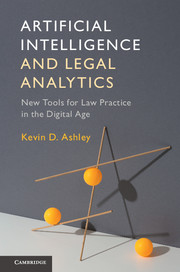Crossref Citations
This Book has been
cited by the following publications. This list is generated based on data provided by Crossref.
Elnaggar, Ahmed
Waltl, Bernhard
Glaser, Ingo
Landthaler, Jörg
Scepankova, Elena
and
Matthes, Florian
2018.
Stop Illegal Comments.
p.
41.
D'Rosario, Michael
and
Hsieh, Calvin
2018.
Predicting Credit Rating Migration Employing Neural Network Models.
International Journal of Strategic Decision Sciences,
Vol. 9,
Issue. 4,
p.
70.
Ashley, Kevin D.
2018.
Handbook of Legal Reasoning and Argumentation.
p.
673.
Palmirani, Monica
Martoni, Michele
Rossi, Arianna
Bartolini, Cesare
and
Robaldo, Livio
2018.
Electronic Government and the Information Systems Perspective.
Vol. 11032,
Issue. ,
p.
139.
Jabłonowska, Agnieszka
Kuziemski, Maciej
Nowak, Anna Maria
Micklitz, Hans-W.
Pałka, Przemysław
and
Sartor, Giovanni
2018.
Consumer Law and Artificial Intelligence: Challenges to the EU Consumer Law and Policy Stemming from the Business' Use of Artificial Intelligence - Final report of the ARTSY project.
SSRN Electronic Journal,
Al-Abdulkarim, Latifa
Atkinson, Katie
Bench-Capon, Trevor
Whittle, Stuart
Williams, Rob
and
Wolfenden, Catriona
2018.
Noise induced hearing loss: Building an application using the ANGELIC methodology.
Argument & Computation,
Vol. 10,
Issue. 1,
p.
5.
Pagallo, Ugo
Palmirani, Monica
Casanovas, Pompeu
Sartor, Giovanni
and
Villata, Serena
2018.
AI Approaches to the Complexity of Legal Systems.
Vol. 10791,
Issue. ,
p.
1.
Sourdin, Tania
and
Cornes, Richard
2018.
The Responsive Judge.
Vol. 67,
Issue. ,
p.
87.
D'Rosario, Michael
and
Zeleznikow, John
2018.
Compliance with International Soft Law.
International Journal of Strategic Decision Sciences,
Vol. 9,
Issue. 3,
p.
1.
Barros, Rhuan
Peres, André
Lorenzi, Fabiana
Krug Wives, Leandro
and
Hubert da Silva Jaccottet, Etiene
2018.
Recent Trends and Future Technology in Applied Intelligence.
Vol. 10868,
Issue. ,
p.
857.
Westermann, Hannes
Walker, Vern R.
Ashley, Kevin D.
and
Benyekhlef, Karim
2019.
Using Factors to Predict and Analyze Landlord-Tenant Decisions to Increase Access to Justice.
p.
133.
Caserta, Salvatore
and
Madsen, Mikael Rask
2019.
The Legal Profession in the Era of Digital Capitalism: Disruption or New Dawn?.
Laws,
Vol. 8,
Issue. 1,
p.
1.
Walton, Douglas
and
Gordon, Thomas F.
2019.
How Computational Tools Can Help Rhetoric and Informal Logic with Argument Invention.
Argumentation,
Vol. 33,
Issue. 2,
p.
269.
Stepanov, Oleg
Pechegin, Denis
Dolova, Mariia
and
Trefilov, Alexander
2019.
Justice and digitalization as mutually determining factors of criminal-jurisdictional activity development.
Bratislava Law Review,
Vol. 3,
Issue. 2,
p.
60.
Lajaunie, Claire
Schafer, Burkhard
and
Mazzega, Pierre
2019.
Big Data Enters Environmental Law.
Transnational Environmental Law,
Vol. 8,
Issue. 3,
p.
523.
Niesen, Tim
Houy, Constantin
and
Fettke, Peter
2019.
Digitale Transformation von Prozessen in der Rechtsberatung: Anwendungsszenarien im Steuerbereich am Beispiel des ARGUMENTUM-Systems.
HMD Praxis der Wirtschaftsinformatik,
Vol. 56,
Issue. 4,
p.
766.
Lippi, Marco
Pałka, Przemysław
Contissa, Giuseppe
Lagioia, Francesca
Micklitz, Hans-Wolfgang
Sartor, Giovanni
and
Torroni, Paolo
2019.
CLAUDETTE: an automated detector of potentially unfair clauses in online terms of service.
Artificial Intelligence and Law,
Vol. 27,
Issue. 2,
p.
117.
Morris, Jason
2019.
User-Friendly Open-Source Case-Based Legal Reasoning.
p.
270.
Navas, Susana
2019.
The Provision of Legal Services to Consumers Using LawTech Tools: From “Service” to “Legal Product”.
Open Journal of Social Sciences,
Vol. 07,
Issue. 11,
p.
79.
Morison, John
and
Harkens, Adam
2019.
Re-engineering justice? Robot judges, computerised courts and (semi) automated legal decision-making.
Legal Studies,
Vol. 39,
Issue. 4,
p.
618.



